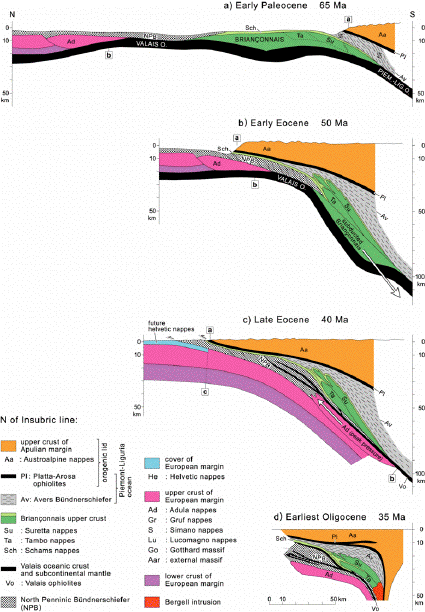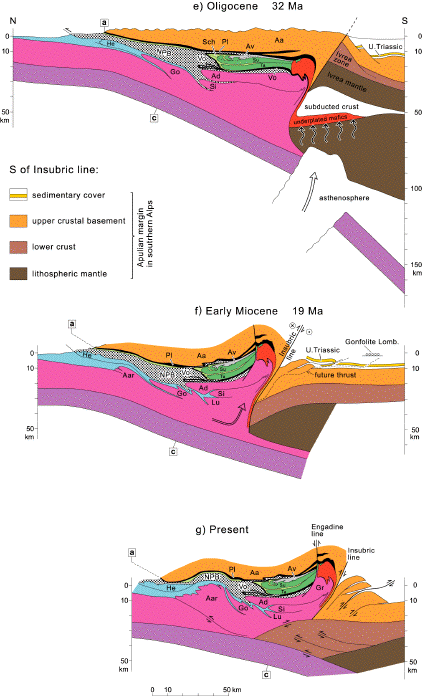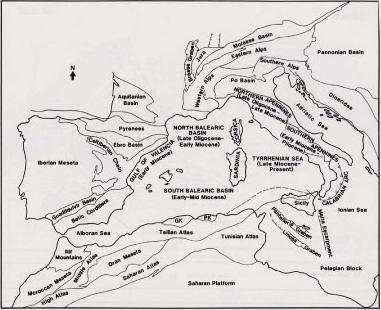

The Alpine belt represents the collision between the Eurasian and African plates. After the breakup of Pangea and the opening of the Atlantic during the early Mesozoic, an ocean known as the "Tethys" separated Africa from Eurasia (Coward & Dietrich, 1989). The Alps are a result of the subduction of the Tethyan ocean underneath Eurasia, followed by the collision with Africa. The building of the Alpine orogen occurred in two distinct episodes: a Cretaceous event involving the Eastern and Western Alps, and a Tertiary event involving the Central Alps (Pfiffner, 1992).
The tectonic evolution of the Alps during the Tertiary collision is shown in Figure 1. The earliest possible onset of thrusting in the units below the Austroalpine nappes (orange) and the Platta-Arosa ophiolites (Pl, thin black line) is locally constrained by ongoing sedimentation in the Brianconnais domain (green). The sketch in Fig.1(a) represents the onset of subduction of the Brianconnais domain (Schmid et al., 1996). By the end of the early Eocene (Fig.1(b), the entire Brianconnais domain has been subducted. At about 50 Ma, the southern tip of stable Europe (pink), represented by the Adula Nappe (Ad) is about to enter the subduction zone. Fig.1(c) shows the subduction of the southern tip of stable Europe (Adula nappe). Eclogite facies formed in the Adula nappe andthen were rapidly exhumed (within 5 m.y.). Fig.1(d) represents the formation of the Penninic nappes. The Penninic nappes were thrust north onto the foreland forcing the detachment of what would later become the Helvetic nappes (He, blue). (Schmid et al., 1996). During the above stages, substantial amounts of continental and oceanic crust were subducted. However, the entire upper continental crust was accreted leading to excessive crustal thickening, which "clogged" the subduction zone such that only the detached lower crust of the European foreland continued to subduct after 19 Ma. (Schmid et al, 1996). Fig.1(e) shows a slab break-off of the European lower plate. The subduction of light continental crust created extensional forces within the slab, due to opposing buoyancy between the deeper subducted, relatively dense lithosphere and the shallower continental lithosphere (Davies & von Blanckenburg, 1995). The breaking off of the slab resulted in the heating and melting of the overriding lithospheric mantle by the upwelling asthenosphere. Fig.1(e) shows the upwelling and emplacement of intrusions. The leading edge of the Helvetic nappes emerged at the erosional front of the Alps in mid-Miocene as shown in Fig.1(f) (Pfiffner, 1985, 19986). The initiation of thrusting in the Molasse basin also occurred during this time period (Schmid et al., 1996). Finally, in Fig.1(g), the Aar massif developed a thrust that delimits the boundary between deformed and undeformed European foreland. Updoming of the Aar massif may be viewed as a crustal-scale ramp fold related to a detachment at the interface between European upper and lower crust (Schmid et al., 1996).
Figure 1
Scaled and area-balanced sketches of the kinematic evolution of the Alps from ea
rly Tertiary convergence and subduction to collision and postcollisional shorten
ing (Schmid et al., 1996).


from Schmid et al., 1996
Figure 2
Outline map of the western Mediterranean Sea and surrouding region showing the major tectonic units in the western Mediterranean and surrounding region. Basins and orogens of importance are labeled with their ages (Dewey et al., 1989).

from Dewey et al., 1989
[ Alpine Overview | Geology |
Geophysics | Geodynamics | Tectonic History |
References ]